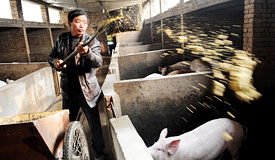|
 |
 |
|
LIVING WITH HOPE: Jiao Baojun, a farmer living with HIV/AIDS in Shangcai County, central China's Henan Province, feeds pigs at his own pig farm on November 25 (ZHU XIANG) |
A COLORFUL LIFE: Five orphans living with HIV/AIDS in a welfare institution in Fuyang City, Anhui Province, touch cartoons painted on the wall of their home that resemble their images (LIU JUNXI) |
Lu believes that the only way to effectively prevent the spread of HIV/AIDS among the elderly is to promote the use of condoms. "You can hardly keep all of them away from sex," he said.
In addition to a growing number of older PLWHA, a rise in the rate of infection among male college students, aged between 20 and 24, has been especially obvious in the past two years, with 56 percent contracting the virus via gay sex, according to the CCDC. Between January and October this year, 1,252 HIV/AIDS cases were detected among college students in medical tests.
"The distribution of HIV/AIDS cases in China is wider and more scattered than ever before, posing great difficulties for prevention and control efforts," said Wu Zunyou, Director of the CCDC's HIV/AIDS Prevention and Control Center, adding that more cases were discovered unexpectedly during routine hospital checks.
According to MOH statistics, ethnic minorities, which account for 8.5 percent of China's total population of 1.3 billion, also often display a high incidence of HIV/AIDS.
In Yunnan and neighboring Guangxi Zhuang Autonomous Region, which are home to dozens of ethnic minorities, HIV/AIDS has become a major threat to public health due to drug abuse and cross-border marriages with citizens from countries with a higher prevalence of HIV/AIDS.
"It is estimated at least 25,000 people in Yunnan, which borders Myanmar, Viet Nam and Laos, are in cross-border marriages, of which HIV carriers and AIDS patients account for 2 percent," said Xu Heping, Director of the Yunnan Provincial Bureau of HIV/AIDS Prevention and Control.
"Because as many as 95 percent of those people are in de facto marriages, or marriages that are not legally registered, it is extremely difficult to offer HIV/AIDS prevention and control services to them," Xu said.
In January, authorities of Ruili City in Yunnan, which borders Myanmar, began providing pre-marriage HIV/AIDS testing, and free anti-viral treatment in hopes of preventing mother-to-child HIV transmission in cases where pregnant women are found to be HIV-positive.
"In Yili Kazakh Prefecture in Xinjiang Uygur Autonomous Region, as well as Ruili and Longchuan County in Yunnan, the HIV infection rate stands at above 1 percent, which is much higher than the country's average, 0.06 percent," said Minister Chen.
Officials and economists warn that the spread of HIV/AIDS in ethnic minority regions, which are often poorer than other parts of China, will slow down their development.
Despite the severe situation, China has made progress in terms of curbing new HIV infections, expanding testing and treatment coverage, and reducing HIV-related deaths.
Newly increased HIV infection cases in China fell from 70,000 in 2005 to around 48,000 this year, according to statistics from the MOH.
Financial support from both central and local governments for HIV/AIDS programs had risen from 1.46 billion yuan ($213.76 million) in 2006 to 3.06 billion yuan ($448.02 million) in 2010.
The Joint UN Programme on HIV/AIDS (UNAIDS) said that China had reported a 60-percent reduction in AIDS-related deaths over the past eight years.
Premier Wen Jiabao on December 1 pledged new measures to help PLWHA obtain affordable drug treatment, enjoy fair job and education opportunities and avoid discrimination.
He said the Chinese Government had decided to roll out special medical aid next year in regions with high HIV/AIDS prevalence to help ease the heavy financial burdens on PLWHA.
"Detailed measures are being drafted by relevant departments," Wen said, adding that some antiretroviral drugs will be included in the country's essential drug system, which means their prices will be controlled and their consumption will be covered by the basic health insurance.
The premier also said that the government would increase financial aid to families impoverished by HIV/AIDS. Measures will include raising allowances and providing subsidized housing to shelter homeless PLWHA.
| 